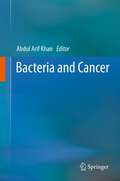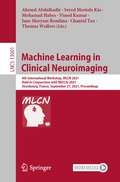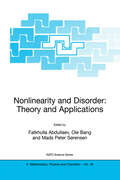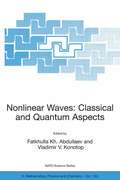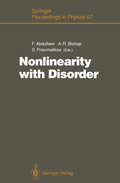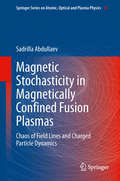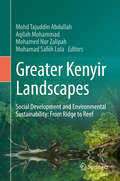- Table View
- List View
Bacteria and Cancer
by Abdul Arif Arif KhanBacterial infections cause substantial morbidity and mortality in cancer patients. These infections always remained enigmatic due to initial reluctance of cancer researchers in understanding their etiologic potential. Etiological association of bacteria with cancer gained credibility after discovery of carcinogenic potential of Helicobacter pylori. Moreover, other suspected associations including Salmonella typhi and gallbladder cancer, Streptococcus bovis and colon cancer, Chlamydia psittaci and ocular adnexal lymphoma and Chlamydia pneumoniae with lung cancer, etc. are looking for a legitimate appraisal to unravel their etiologic potential without prejudice. In contrary, bacteria also show protective role in certain types of cancer. Certain agents derived from bacteria are successfully in practice for the management of cancer. The integrate association of bacteria and cancer is evident in both positive and negative aspects. The role of bacteria in cancer etiology and treatment is vigorously studied since last few years. Present book tries to provide current status of research undergoing in above direction, with the glimpses of future possibility for using microbiological knowledge in the management of this deadly killer.This book will interest specialists dealing with cancer associated infectious complications, researchers working in the field of cancer biology, teachers and scientists in the field of microbiology, biotechnology, medicine and oncology. The unique coverage of bacteriology and cancer association in both positive and negative way can usher into development of novel thrust area for microbiology students and experts.
Computational Biomechanics of the Hip Joint (SpringerBriefs in Applied Sciences and Technology)
by Mohammed Rafiq Abdul KadirThis book presents analyses of the most commonly reported failure modes of hip stems: loosening and thigh pain; both are attributed to the relative motion and instability at the bone-implant interface due to failure to achieve sufficient primary fixation. The book investigates various factors that could affect primary stability and therefore the long-term outcome of hip arthroplasty. The results complement experimental work carried out in this area as in-vitro experiments have several limitations that could be addressed through computer simulations.
Nanotechnologies in Green Chemistry and Environmental Sustainability (Sustainability: Contributions through Science and Technology)
by Abdul Karim, Samsul AriffinNanotechnologies represent a fast-growing market and this unique volume highlights the current studies in applied sciences on sustainability of green science and technology. The chapters include modelling, machine learning, nanotechnology, nanofluids, nanosystems, smart materials and applications and solar and fuel cells technology. The authors cover simulation, additive manufacturing, machine learning and the autonomous system. Various aspects of green science as well as trans-disciplinary topics between fundamental science and engineering are presented.The book is suitable for all postgraduates and researchers working in this rapid growing research area. Features Presenting latest research on green materials and sustainability. Provide in depth discussion on modeling and simulation using latest techniques. Technical exposure for the readers on additive manufacturing principles. Numerous examples on nanofluids and nano technology are presented. Discusses computer modeling, superconductivity, nanotubes and related structures such as graphene.
Environmental Protection Strategies for Sustainable Development (Strategies for Sustainability)
by Abdul Malik and Elisabeth GrohmannThe environment of our planet is degrading at an alarming rate because of non-sustainable urbanization, industrialization and agriculture. Unsustainable trends in relation to climate change and energy use, threats to public health, poverty and social exclusion, demographic pressure and ageing, management of natural resources, biodiversity loss, land use and transport still persist and new challenges are arising. Since these negative trends bring about a sense of urgency, short term action is required, whilst maintaining a longer term perspective. The main challenge is to gradually change our current unsustainable consumption and production patterns and the nonintegrated approach to policy-making. This book covers the broad area including potential of rhizospheric microorganisms in the sustainable plant development in anthropogenic polluted soils, bioremediation of pesticides from soil and waste water, toxic metals from soil, biological treatment of pulp and paper industry wastewater, sustainable solutions for agro processing waste management, solid waste management on climate change and human health, environmental impact of dyes and its remediation. Various methods for genotoxicity testing of environmental pollutants are also discussed and chapters on molecular detection of resistance and transfer genes in the environmental samples, biofilm formation by the environmental bacteria, biochemical attributes to assess soil ecosystem sustainability, application of rhizobacteria in biotechnology, role of peroxidases as a tool for the decolorization and removal of dyes and potential of biopesticides in sustainable agriculture. It offers a unique treatment of the subject, linking various protection strategies for sustainable development, describing the inter-relationships between the laboratory and field eco-toxicologist, the biotechnology consultant, environmental engineers and different international environmental regulatory and protection agencies.
Management of Microbial Resources in the Environment
by Abdul Malik, Elisabeth Grohmann and Madalena AlvesThis volume details the exploration, collection, characterization, evaluation and conservation of microbes for sustainable utilization in the development of the global as well as national economies, e.g. in agriculture, ecosystems, environments, industry and medicine. Many research institutes and universities all over the world carry out microbiological and biotechnological research, which generates substantial genomic resources such as cDNA libraries, gene constructs, promoter regions, transgenes and more valuable assets for gene discovery and transgenic product development. This work provides up-to-date information on the management of microbial resources in the environment. It also covers the ecology of microorganisms in natural and engineered environments. In trying to understand microbial interactions it further focuses on genomic, metagenomic and molecular advances, as well as on microbial diversity and phylogeny; ecological studies of human, animal and plant microbiology and disease; microbial processes and interactions in the environment; and key technological advances. Though not intended to serve as an encyclopedic review of the subject, the various chapters investigate both theoretical and practical aspects and provide essential basic information for future research to support continued development.
Novel Sensors for Food Inspection: Modelling, Fabrication And Experimentation (Smart Sensors, Measurement and Instrumentation #10)
by Mohd Syaifudin Abdul Rahman Subhas Chandra Mukhopadhyay Pak-Lam YuThis book addresses presents recent developments of novel planar inter digital sensors for food inspection. It covers the fundamentals of sensors, their design, modelling and simulations, fabrications, characterizations, experimental investigations and analyses. This book will be useful for the engineers and researchers especially higher undergraduate, postgraduate students as well as practitioners working on the development of Electromagnetic Sensors.
Optical Guided-wave Chemical and Biosensors II (Springer Series on Chemical Sensors and Biosensors #8)
by I. Abdulhalim H. S. Dhadwal T. Eftimov M. El-Sherif X. Fan Y. Fang Y. Matsuura A. Menikh B. L. Miller H. Schmidt M. Skorobogatiy J. D. Suter H. ZhuMohammed Zourob Akhlesh LakhtakiaFor the first time, distinguished scientists from key institutions worldwide provide a comprehensive approach to optical sensing techniques employing the phenomenon of guided wave propagation for chemical and biosensors. This includes both state-of the-art fundamentals and innovative applications of these techniques. The authors present a deep analysis of their particular subjects in a way to address the needs of novice researchers such as graduate students and post-doctoral scholars as well as of established researchers seeking new avenues. Researchers and practitioners who need a solid foundation or reference will find this work invaluable. This second of two volumes covers the incorporation of periodic structures in waveguides to exploit the Bragg phenomenon, optical fiber sensors, hollow waveguides and micro-resonators as well as a review of the tremendous expansion of terahertz technology for sensing applications.
Prospects in Bioscience: Addressing the Issues
by Abdulhameed Sabu and Anu AugustineThe book entitled “Prospects in Bioscience: Addressing the issues” is a collection of selected research papers presented at the International Conference on Advances in Biological Sciences (ICABS) organized by the Department of Biotechnology and Microbiology and the Inter University Centre for Bioscience, Kannur University, Kerala, India. ICABS witnessed a unique spectrum of Scientific Programmes on the most recent and exciting developments in modern biology. The conference displayed the numerous breakthroughs and significant developments in the important areas of modern biology and their relevance to the welfare of global society. The Book contains 50 well written chapters, each one discussing scientifically organized findings of original research work done in reputed laboratories. Needless to say, they deal with advances in various disciplines of modern biology including Cell and Molecular Biology, Structural Biology, Industrial and Environmental Biotechnology, Food and Agricultural Biotechnology and Medical Biotechnology. As the title rightly indicates, the chapters project the prospects in the respective areas and the issues in them. Specific issues discussed in the book includes development of transgenic plants, bioremediation of toxic industrial effluents, biotransformation for novel antibiotics, biofertilizer development, molecular drug designing and structure elucidation, molecular identification of pathogens, production of anti microbials, biocontrol agents and bioactive molecules, cancer biology, plant breeding and hybrid seed production etc. The book with its contents spreading across the vast arena of modern biology is expected to cater to the need of researchers, technologists and students.
Bioresources and Bioprocess in Biotechnology: Volume 1: Status and Strategies for Exploration
by Sabu Abdulhameed N. S. Pradeep Shiburaj SugathanThis book is a compilation of articles on various aspects of bioresources and the processes employed for its judicious utilization. Biodiversity and conservation, food security, gene banks and repositories, laws governing biodiversity, bioprospecting, bioresources in traditional medicine and biodiversity mining are some of the important topics covered in the book. The unique contents of the book make it an important source of information for conservation scientists, academics, activists and to those who are actively involved in product oriented research from bioresources.
Machine Learning in Clinical Neuroimaging: 4th International Workshop, MLCN 2021, Held in Conjunction with MICCAI 2021, Strasbourg, France, September 27, 2021, Proceedings (Lecture Notes in Computer Science #13001)
by Ahmed Abdulkadir Seyed Mostafa Kia Mohamad Habes Vinod Kumar Jane Maryam Rondina Chantal Tax Thomas WolfersThis book constitutes the refereed proceedings of the 4th International Workshop on Machine Learning in Clinical Neuroimaging, MLCN 2021, held on September 27, 2021, in conjunction with MICCAI 2021. The workshop was held virtually due to the COVID-19 pandemic. The 17 papers presented in this book were carefully reviewed and selected from 27 submissions. They were organized in topical sections named: computational anatomy and brain networks and time series.
Nonlinearity and Disorder: Theory and Applications (NATO Science Series II: Mathematics, Physics and Chemistry #45)
by Fatkhulla Abdullaev Ole Bang Mads Peter SørensenProceedings of the NATO Advanced Research Workshop, Tashkent, Uzbekistan, 2-6 October 2001
Nonlinear Waves: Classical and Quantum Aspects (NATO Science Series II: Mathematics, Physics and Chemistry #153)
by Fatkhulla Abdullaev Vladimir V. KonotopLeading scientists discuss the most recent physical and experimental results in the physics of Bose-Einstein condensate theory, the theory of nonlinear lattices (including quantum and nonlinear lattices), and nonlinear optics and photonics. Classical and quantum aspects of the dynamics of nonlinear waves are considered. The contributions focus on the Gross-Pitaevskii equation and on the quantum nonlinear Schrödinger equation. Recent experimental results on atomic condensates and hydrogen bonded systems are reviewed. Particular attention is given to nonlinear matter waves in periodic potential.
Nonlinearity with Disorder: Proceedings of the Tashkent Conference, Tashkent, Uzbekistan, October 1–7, 1990 (Springer Proceedings in Physics #67)
by Fatkulla Abdullaev Alan R. Bishop Stephanos PnevmatikosIn the past three decades there has been enormous progress in identifying the essential role that nonlinearity plays in physical systems, including supporting soliton-like solutions and self-trapped sxcitations such as polarons. during the same period, similarly impressive progress has occurred in understanding the effects of disorder in linear quantum problems, especially regarding Anderson localization arising from impurities, random spatial structures, stochastic applied fields, and so forth. These striking consequences of disorder, noise and nonlinearity frequently occur together in physical systems. Yet there have been only limited attempts to develop systematic techniques which can include all of these ingredients, which may reinforce, complement or frustrate each other. This book contains a range of articles which provide important steps toward the goal of systematic understanding and classification of phenomenology. Experts from Australia, Europe, Japan, USA, and the USSR describe both mathematical and numerical techniques - especially from soliton and statistical physics disciplines - and applicaations to a number of important physical systems and devices, including optical and electronic transmission lines, liquid crystals, biophysics and magnetism.
Magnetic Stochasticity in Magnetically Confined Fusion Plasmas: Chaos of Field Lines and Charged Particle Dynamics (Springer Series on Atomic, Optical, and Plasma Physics #78)
by Sadrilla AbdullaevThis is the first book to systematically consider the modern aspects of chaotic dynamics of magnetic field lines and charged particles in magnetically confined fusion plasmas. The analytical models describing the generic features of equilibrium magnetic fields and magnetic perturbations in modern fusion devices are presented. It describes mathematical and physical aspects of onset of chaos, generic properties of the structure of stochastic magnetic fields, transport of charged particles in tokamaks induced by magnetic perturbations, new aspects of particle turbulent transport, etc. The presentation is based on the classical and new unique mathematical tools of Hamiltonian dynamics, like the action--angle formalism, classical perturbation theory, canonical transformations of variables, symplectic mappings, the Poincaré-Melnikov integrals. They are extensively used for analytical studies as well as for numerical simulations of magnetic field lines, particle dynamics, their spatial structures and statistical properties. The numerous references to articles on the latest development in the area are provided. The book is intended for graduate students and researchers who interested in the modern problems of magnetic stochasticity in magnetically confined fusion plasmas. It is also useful for physicists and mathematicians interested in new methods of Hamiltonian dynamics and their applications.
Construction of Mappings for Hamiltonian Systems and Their Applications (Lecture Notes in Physics #691)
by Sadrilla S. AbdullaevBased on the method of canonical transformation of variables and the classical perturbation theory, this innovative book treats the systematic theory of symplectic mappings for Hamiltonian systems and its application to the study of the dynamics and chaos of various physical problems described by Hamiltonian systems. It develops a new, mathematically-rigorous method to construct symplectic mappings which replaces the dynamics of continuous Hamiltonian systems by the discrete ones. Applications of the mapping methods encompass the chaos theory in non-twist and non-smooth dynamical systems, the structure and chaotic transport in the stochastic layer, the magnetic field lines in magnetically confinement devices of plasmas, ray dynamics in waveguides, etc. The book is intended for postgraduate students and researches, physicists and astronomers working in the areas of plasma physics, hydrodynamics, celestial mechanics, dynamical astronomy, and accelerator physics. It should also be useful for applied mathematicians involved in analytical and numerical studies of dynamical systems.
Nanomaterials in Daily Life: Compounds, Synthesis, Processing and Commercialization
by Zhypargul AbdullaevaThis book describes nanomaterials used and existing in the environment, food industry and packaging, health care products and cosmetics, housekeeping, nanomaterials for cleaning purposes, architectural building products, medicine, clothing and textile, smart electronics and sensors. Each chapter provides basic knowledge on synthesis of nanomaterials by biological approaches. Fundamental terms are defined, followed by explanatons, examples, visual photographs, schemes and illustrations.
Springback Assessment and Compensation of Tailor Welded Blanks
by Ab Abdullah Mf JamaludinFocusing on techniques developed to evaluate the forming behaviour of tailor welded blanks (TWBs) in sheet metal manufacturing, this edited collection details compensation methods suited to mitigating the effects of springback. Making use of case studies and in-depth accounts of industry experience, this book gives a comprehensive overview of springback and provides essential solutions necessary to modern-day automotive engineers. Sheet metal forming is a major process within the automotive industry, with advancement of the technology including utilization of non-uniform sheet metal in order to produce light or strengthened body structures. This is critical in the reduction of vehicle weight in order to match increased consumer demand for better driving performance and improved fuel efficiency. Additionally, increasingly stringent international regulations regarding exhaust emissions require manufacturers to seek to lighten vehicles as much as possible. To aid engineers in optimizing lightweight designs, this comprehensive book covers topics by a variety of industry experts, including compensation by annealing, low-power welding, punch profile radius and tool-integrated springback measuring systems. It ends by looking at the future trends within the industry and the potential for further innovation within the field. This work will benefit car manufacturers and stamping plants that face springback issues within their production, particularly in the implementation of TWB production into existing facilities. It will also be of interest to students and researchers in automotive and aerospace engineering.
Modelling Approaches to Understand Salinity Variations in a Highly Dynamic Tidal River: The Case of the Shatt al-Arab River (IHE Delft PhD Thesis Series)
by Ali Dinar AbdullahThis book reports the first systematic monitoring and modelling study on water availability, water quality and seawater intrusion of the Shatt al-Arab River (SAR) on the border of Iraq and Iran, where causes and concentration levels of salinity have not yet been fully understood, let alone addressed, leading to conflicting perceptions of its origin (external or internal), the natural conditions and the practices that can explain the current critical conditions. Current scientific knowledge on the SAR salinity problem is deficient, partially due to the complex and dynamic interaction between marine and terrestrial salinity sources, including return flows by water users of the different water sectors in the Euphrates and Tigris rivers upstream of the SAR. The development of a new series of monitoring stations and various modelling approaches helped to better understand the interactions between these different sources. The comprehensive and detailed dataset formed the basis for a validated analytical model that can predict the extent of seawater relative to other salinity sources in an estuary, and for a hydrodynamic model that can predict salinity changes. The adaptability of the models to changing conditions makes them directly applicable by water managers. The procedure can be applied to other comparable systems.
Modelling Approaches to Understand Salinity Variations in a Highly Dynamic Tidal River: The Case of the Shatt al-Arab River (IHE Delft PhD Thesis Series)
by Ali Dinar AbdullahThis book reports the first systematic monitoring and modelling study on water availability, water quality and seawater intrusion of the Shatt al-Arab River (SAR) on the border of Iraq and Iran, where causes and concentration levels of salinity have not yet been fully understood, let alone addressed, leading to conflicting perceptions of its origin (external or internal), the natural conditions and the practices that can explain the current critical conditions. Current scientific knowledge on the SAR salinity problem is deficient, partially due to the complex and dynamic interaction between marine and terrestrial salinity sources, including return flows by water users of the different water sectors in the Euphrates and Tigris rivers upstream of the SAR. The development of a new series of monitoring stations and various modelling approaches helped to better understand the interactions between these different sources. The comprehensive and detailed dataset formed the basis for a validated analytical model that can predict the extent of seawater relative to other salinity sources in an estuary, and for a hydrodynamic model that can predict salinity changes. The adaptability of the models to changing conditions makes them directly applicable by water managers. The procedure can be applied to other comparable systems.
Photocatalytic Activities for Environmental Remediation and Energy Conversion (Green Energy and Technology)
by Hairus AbdullahThis book highlights sustainable methods with photocatalytic activities to remediate environment and for energy conversion. The related photocatalytic materials are discussed in detail. Some significant photocatalytic applications in degrading industrial pollutants that include different organic dyes, purifying the polluted air, converting CO2 to alcohol fuels, storing energy from sunlight as ammonia by converting N2 to NH3, and splitting water by optimizing the oxygen evolution process are thoroughly elucidated. The chapters introduce the necessary materials and results, leading to a better conceptualization in order to work in the field of photocatalysis. Some related perspectives and outlooks are discussed in the last chapter for possible future developments.
Solar Light-to-Hydrogenated Organic Conversion: Heterogeneous Photocatalysts
by Hairus AbdullahThis book highlights the promising photocatalytic methods for synthesizing organic chemicals by simultaneously degrading the toxicity of raw substances used for organic synthesis. It presents various semiconducting materials with high catalytic activities in hydrogen evolution reactions (HERs) and hydrogenation reactions, as well as the material characterizations for identifying semiconductor photocatalysts. The focus is on understanding the hydrogen dissociation and activation of substances in the process of hydrogenation and the fabrication of nanostructured catalysts with desired activity and selectivity. Recent works show photocatalytic hydrogenation reactions with in situ generated H+ on catalyst surfaces utilizing initial chemicals such as nitrophenol, nitrobenzene, azobenzene, and benzene for valorization. In addition, the photocatalytic valorization of waste glycerol is also discussed. Besides the hydrogenation reactions, the reduction of oxygen to form H2O2 can be done with a photocatalytic method in atmospheric conditions. Some related perspectives and outlooks are also discussed for possible future development.
Bioresources Technology in Sustainable Agriculture: Biological and Biochemical Research
by Mohamad Faiz Foong Abdullah Mohd Tajudin Bin Ali Farida Zuraina M. YusofThis book focuses on cutting-edge advances and applications in tropical agriculture and bioresources. It outlines some of the newest advances, basic tools, and the applications of novel approaches to improve agricultural practices and utilization of bioresources for the enhancement of human life. Highlights include a thorough discussion on various aspects of agricultural modernization through technological advances in information technology, efficient utilization of under-exploited natural bioresources, new chemical approaches for the generation of novel biochemicals, and the applications of forensic and genetics approaches for bioresource conservation.
Applied Energy: An Introduction
by Mohammad Omar AbdullahWritten in clear, concise language and designed for an introductory applied energy course, Applied Energy: An Introduction discusses energy applications in small-medium enterprises, solar energy, hydro and wind energy, nuclear energy, hybrid energy, and energy sustainability issues. Focusing on renewable energy technologies, energy conversion, and
Resource Use and Sustainability of Orang Asli: Indigenous Communities in Peninsular Malaysia
by Mohd Tajuddin Abdullah Candyrilla Vera Bartholomew Aqilah MohammadComprising of 18 sub-ethnic groups the indigenous communities, or better known as the Orang Asli, located in the Peninsular Malaysia, is a unique community in terms of their culture, lifestyle, and heritage. The life of the Orang Asli, popularly referred to as the Forest People, is highly intertwined with forest resources which makes the community a great source of information and traditional knowledge, particularly in the use of medicinal plants. This book covers three important issues to explain and gain insights into the sustainability of the Orang Asli:Social and demographicsSustainability of resource useGovernance, administration and management The book presents research to help bridge the gaps and provides a baseline reference for further research regarding the sustainability of the Orang Asli. This book is intended for researchers and graduate students to help gain an understanding of the Orang Asli. By highlighting the plight of Orang Asli the authors hope that this community will be recognised and become a part of society. More research is required to help the 178,197 Orang Asli achieve the sustainable development goals for their community in the Peninsular Malaysia.
Greater Kenyir Landscapes: Social Development and Environmental Sustainability: From Ridge to Reef
by Mohd Tajuddin Abdullah Aqilah Mohammad Mohamed Nor Zalipah Muhamad Safiih LolaThis book contains research findings from three major study areas, natural sciences, social sciences, and public policy and management. The focus area extends over geographical zones ranging from mountainous area of Mount Gagau in the Taman Negara National Park, down to the coastal islands of Bidong, Redang and Perhentian on the eastern coast of Peninsular Malaysia. Chapters on natural sciences examine the physicochemical characteristics of water, physiological and ecological constraints to geological and climatological aspects. The social science and management chapters observe the rich ethno-heritage of local communities and how they interact and develop as a culture, and public policy for sustainable management. Viewpoints from political science, history, sociology, economics, anthropology and management science are also taken into account. This book is intended for researchers and graduate students to create an understanding of the rich heritage, while policy makers plan for future generations. Readers will benefit from this book by studying the gaps in the current knowledge and move to develop further research to understand the unexplored forest canopies and the dynamics of the changing Greater Kenyir landscapes.
